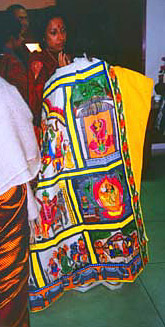PATS: BENGALI SCROLL PAINTINGS
[See example of a Pat with commentary]
The presence of patuas or itinerant artist-minstrels is attested to from antiquity, since the seventh century literary text, Bana’s drama Harshacharita, mentions artists who exhibited scrolls that narrated the rewards and punishments conferred upon a person by Yama, the Lord of Death. Though the tradition of pats or scroll paintings is today associated with Bengal, it is possible that it was more widespread in pre-modern India. The artist would carry a number of such scroll paintings from place to place, and when he arrived at a village and had an audience gathered around him, he would undo the scroll painting panel by panel, narrating or singing the story as he went along, taking perhaps as much as ten or fifteen minutes to finish his narration. More often than not the stories were well-known to the listeners, but each patua or chitrakar, picture-maker, furnished a slightly different inflection to the tale, attaching rather more importance to some parts of the narrative. Not every scroll painting carried by an artist had been executed by him; some doubtless belonged to the family.
 The pats were at one time painted on cloth but are now largely executed on cheap hand-made paper that is stitched together with a cotton thread. The scrolls are almost always unmounted. Though synthetic dyes have been in use for some years, at one time only vegetable dyes and natural pigments were used, and a starch derived from the bel fruit was used as binding material. Scroll paintings can be as short as four feet, and as long as fifty feet, but the average length of a scroll is closer to fifteen feet. The scroll is divided into vertical panels, again not always of equal length, and each panel narrates an episode of the story, for instance: the exile of Rama, Lakshmana, and Sita into the forest; the abduction of Sita; the burning of Lanka by Hanuman; and the death of Ravana. Bright colors, such as red, yellow, green, and blue predominate, and the background color is most often red. The chitrakars come from both Hindu and Muslim castes, and some persons have syncretic names; and as is not uncommon in artisan groups, Hindu and Muslim customs are often commingled, and Muslim chitrakars are just as adept at the representation of Hindu myths.
The pats were at one time painted on cloth but are now largely executed on cheap hand-made paper that is stitched together with a cotton thread. The scrolls are almost always unmounted. Though synthetic dyes have been in use for some years, at one time only vegetable dyes and natural pigments were used, and a starch derived from the bel fruit was used as binding material. Scroll paintings can be as short as four feet, and as long as fifty feet, but the average length of a scroll is closer to fifteen feet. The scroll is divided into vertical panels, again not always of equal length, and each panel narrates an episode of the story, for instance: the exile of Rama, Lakshmana, and Sita into the forest; the abduction of Sita; the burning of Lanka by Hanuman; and the death of Ravana. Bright colors, such as red, yellow, green, and blue predominate, and the background color is most often red. The chitrakars come from both Hindu and Muslim castes, and some persons have syncretic names; and as is not uncommon in artisan groups, Hindu and Muslim customs are often commingled, and Muslim chitrakars are just as adept at the representation of Hindu myths.
There is a specific class of Yama or Jadu (Magic) pats, designed largely for the Santal tribespeople, in which the dead are endowed with sight by means of magic. But the stories generally told in scroll paintings are derived from the Ramayana, the Mahabharata, the puranas, or other mythological lore and folk tales which are sometimes specific to Bengal, such as tales about the snake-goddess, Manasa. The Krishna-Radha legends are a favorite subject matter for the pats, as are tales about Shiva and his consort Parvati; but by no means are all the stories derived from religious or mythological literature. Sometimes the subjects are derived from social and political issues of the day, or are intended to satirize prevalent social mores. As the accompanying slide show of one pat suggests, even topics like AIDS have reached the attention of patuas. Some observers have suggested that the art of the patua is rapidly disappearing, and certain the advent of cinema and cable television has jeopardized a great many traditional art forms. However, like many other predictions made of Indian conditions, this one is far from being fulfilled at the present moment, and it is possible that amidst the technological innovations and splendors of our times, some people may yet discover the simpler pleasures of life.
Further Reading
Subramanyan, K. G. “The comic-strip of the Bengal Village.” In India, Volume “Specially Published for the Festival of India in the U.S.A.” Bangkok: Media Transasia Limited under sponsorship of Festival of India, 1985, pp. 49-53.


